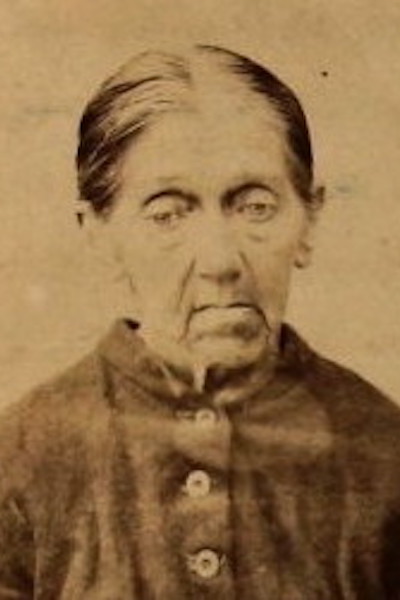
Meet my ancestor Jane MAPLESDEN (nee GOODWIN) 1824-1886. Daughter of John GOODWIN (Most likely 1790-1835) and his wife Jane GOODWIN (nee HEASMAN). They married in Cowden, Kent on 7th December 1815.
After nine years of childless marriage, on 15th February 1824, Jane GOODWIN was born near Tunbridge Wells in Kent. She is believed to have been baptised when she was one month old, on 17th March 1824, in a small village called Speldhurst, which is just near to Tunbridge Wells and about 6 miles away from Cowden where her parents had married.
Jane appears to have grown up an only child, which would have been quite unusual in those days. There is some later evidence that her childhood was not a very happy one, her father is believed to have been a “Drunkard” who died when she was around ten years old, and her Mother became mentally unwell and was labelled a “Lunatic”.
Little else is known about her childhood except for the fact that the 1841 census shows that a Jane Goodwin was living at the age of 15 with her mother and father in a property called Vauxhall House in Kent. However, it is not clear whether this was our Jane because her father is believed to have died prior to this census being recorded. It’s also difficult to establish what the John GOODWIN listed on this census did for a living because it says he was “Licensed…” but then it’s unclear as to what was written after that. Possibly an ‘Undertaker’ or something ‘maker’ or possibly the licence related to a public house. My ancestor Jane MAPLESDEN nee GOODWIN however states at her marriage in Woolwich in 1845, that her father was a ‘Gentleman’.
What is definitely known, is that at some point during her youth, Jane would meet a young farmer named Charles MAPLESDEN who was four years older than her, and who had been born in ‘Nettlested’ or Nettlestead in Kent. They would go on to marry and have lots of children together, but there is evidence to show that the marriage was not to be a happy one.
Jane Marries Charles MAPLESDEN
On 27th October 1845, when Jane was 21 years old, she married Charles MAPLESDEN at the Parish Church St Mary Magdalene in Woolwich, near London. This was around 30 miles away from her village of Speldhurst near Tunbridge Wells and Charles’ village of Nettlestead, so it’s not clear why they got married in this particular church. Perhaps it was for religious reasons, however, it’s also possible that they were living there because the marriage was licensed by Banns and the register says that they were both ‘of the parish’. It seems that the marriage was not witnessed by either of their parents. Instead, it was witnessed by a William and Sophia WILLS. They provide some details of their fathers’ occupations, listing Charles’ father as a farmer named George MAPLESDEN, and Jane’s father as a ‘Gentleman’.

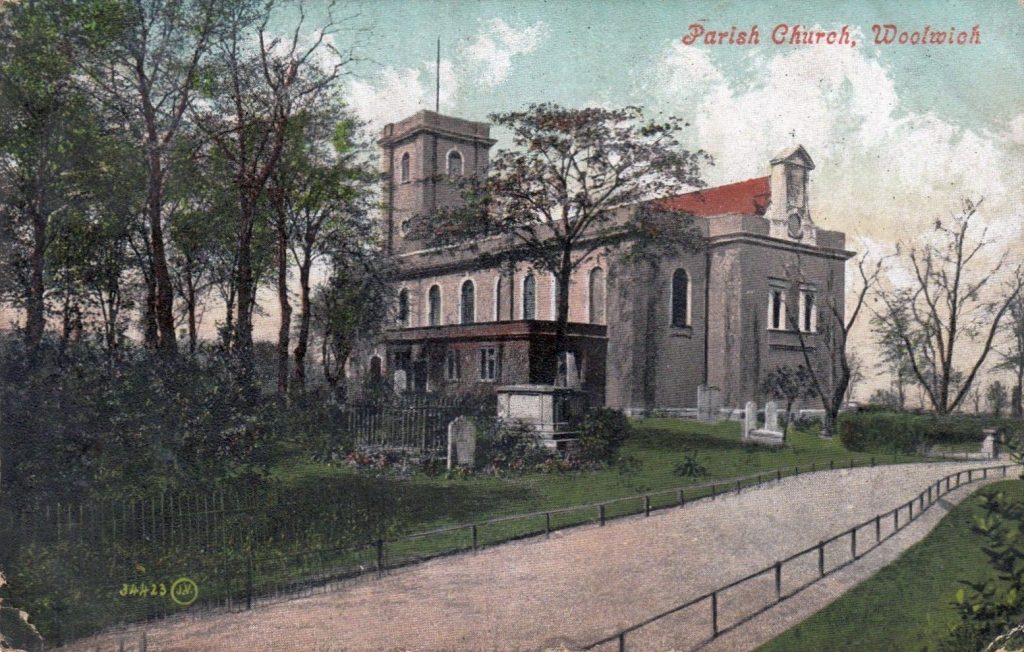


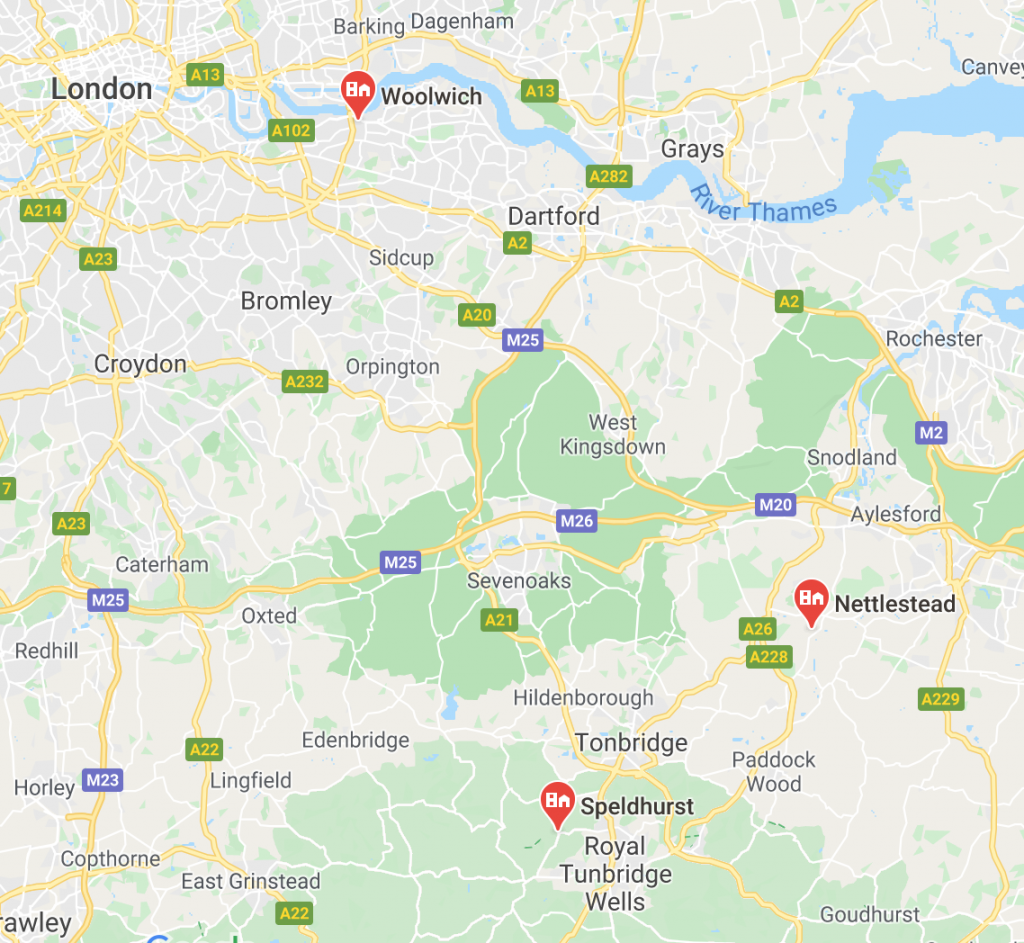
Following their marriage, the couple resided together at a Farm called Powder Hill Farm at Southborough, Kent. This was close to Speldhurst where Jane had been born and close to Tonbridge and Tunbridge Wells. Powder Mill Lane, where the young couple went to live, was the site of a new Corn Mill erected in or around 1845, which would go into production and function for the next hundred years so perhaps Charles went to work there as a young man.
Unfortunately, we know from Jane’s own account which was given in evidence many years later, that things changed shortly after they married and the marriage was not a happy one for Jane. In her own words she said
“he treated me with great unkindness and continually and on frequent occasions assaulted and beat and otherwise ill used me”
Nevertheless, about a year after they married, in October 1846, and while they were still living together at Southborough, the couple had their first child together, a son. They named him Charles MAPLESDEN, most likely after the baby’s own father and Jane’s husband, Charles. They then had a second child together the following year, another son, who they named George MAPLESDEN, most likely after Charles’ father George MAPLESDEN.
Ashes Farm, Hadlow
At some time around 1848, the family moved together to live at Ashes Farm in Ashes Lane, Hadlow in Kent. This was a large farm of 60 acres part way between the two villages where they respectively grew up.

There they had a third child. This time it was a daughter, who they named Sophia MAPLESDEN (perhaps after Sophia WILLS who witnessed the couple’s marriage).
In 1851, the census (which has been incorrectly digitalised and is therefore listed as ‘Maplerden’) shows that the young family were living at Ashes Farm in Hadlow, Kent. Charles was now aged 31 and was listed as a Farmer of 60 acres. He was listed as employing 2 labourers. Jane was now aged 26, listed as a farmer’s wife, and the family have their three young children living with them: Charles (listed as a scholar despite being aged just 4 years old), George aged 3 and Sophia now aged 1. They also had two young ‘agricultural labourers’ living with them, named George YOUNG who is 24 and James TIMMONS who was 16. There is also a young female Farm Servant named Emily CHITTENDEN who was 19.
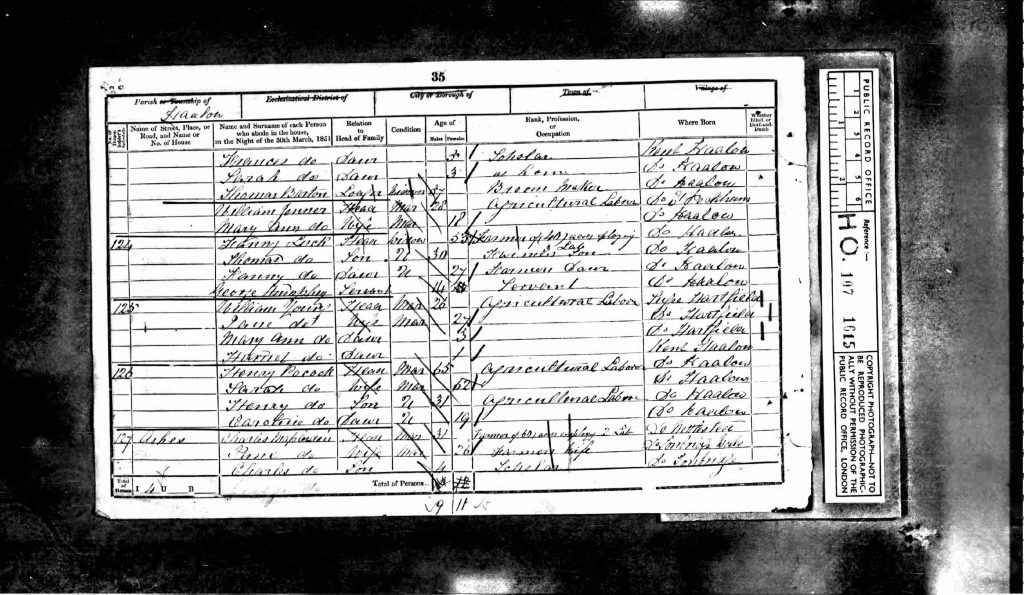
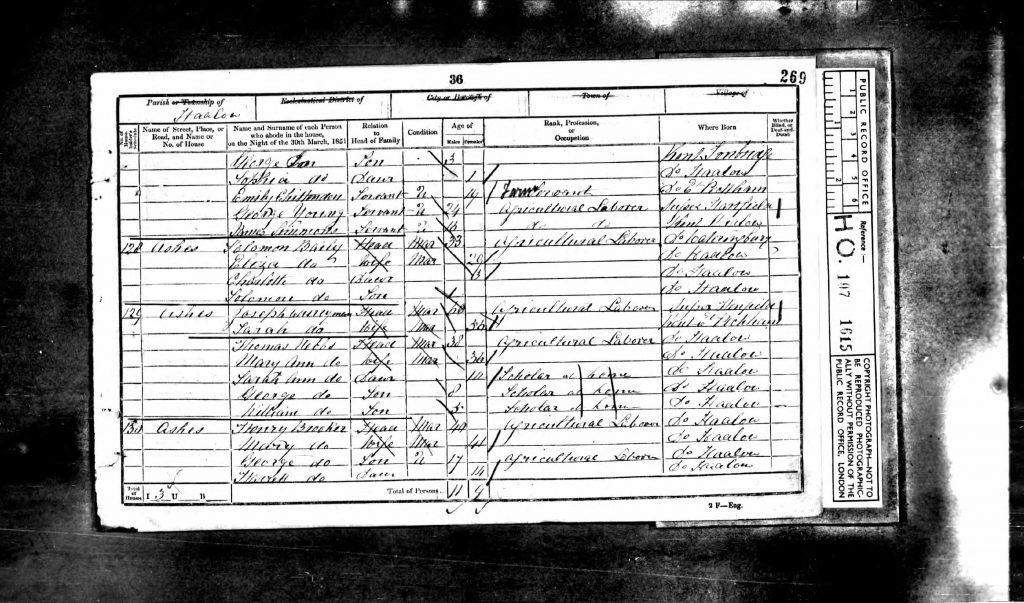
In 1852, Charles and Jane had a fourth child, a son, who they named John MAPLESDEN, and in late 1853 or early 1854, they had another son, who they named Thomas MAPLESDEN (he was my Great Great Grandfather).
On 2nd April 1854, Jane’s mother, Jane GOODWIN (nee HEASMAN) died in Buxted, Sussex and in November of the same year, 1854, Charles and Jane had another baby, their sixth child together. This was another son, who they named Stephen MAPLESDEN.
Bank Farm, Capel
At some point in or around 1855, the family moved together to a property that would become their main family home for a long time to come but which would unfortunately bring more trouble and unhappiness for Jane: a large farm of 75 acres named Bank Farm, at Capel near Tudeley in Kent.
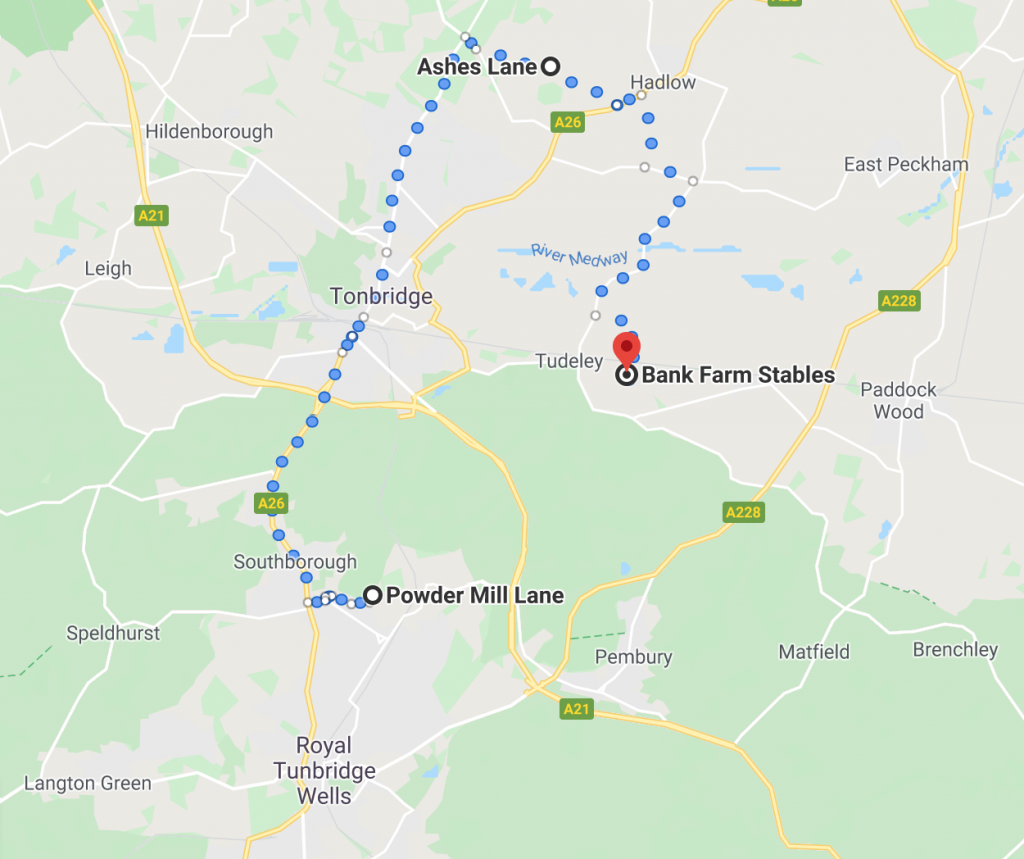
In 1856, while living at their new farm, the couple have another son, William MAPLESDEN, followed by a daughter, Esther (1858) and then another daughter, Elizabeth (1859). Then, in around 1860, either shortly before or even while Jane is pregnant with their tenth child, things would take a turn for the worse for the family when a young woman came to the farm.
Mary ADAMS Arrives at Bank Farm
Needing help in the home and on the farm, Jane and Charles hired a young woman, who was at this time aged just 16 or 17 years old. She was named Mary ADAMS. She came to live with the family and their other staff at Bank Farm, and began work as a General Servant.
The 1861 census listed Charles and Jane as living with their now very large family of nine children, along with their staff. To help with the children and domestic chores, Jane had a Nurse Maid named Sarah WALTER (aged 17). Charles had a ‘Carters Mate’ named William RING (16) to help with carting and farm work and also another lad, named William NIBS, who was listed as an ‘Odd Man’ to help with odd jobs around the farm. The census also lists Mary ADAMS as a ‘General Servant’ who was also living with them and working around the farm and in the home at this time.
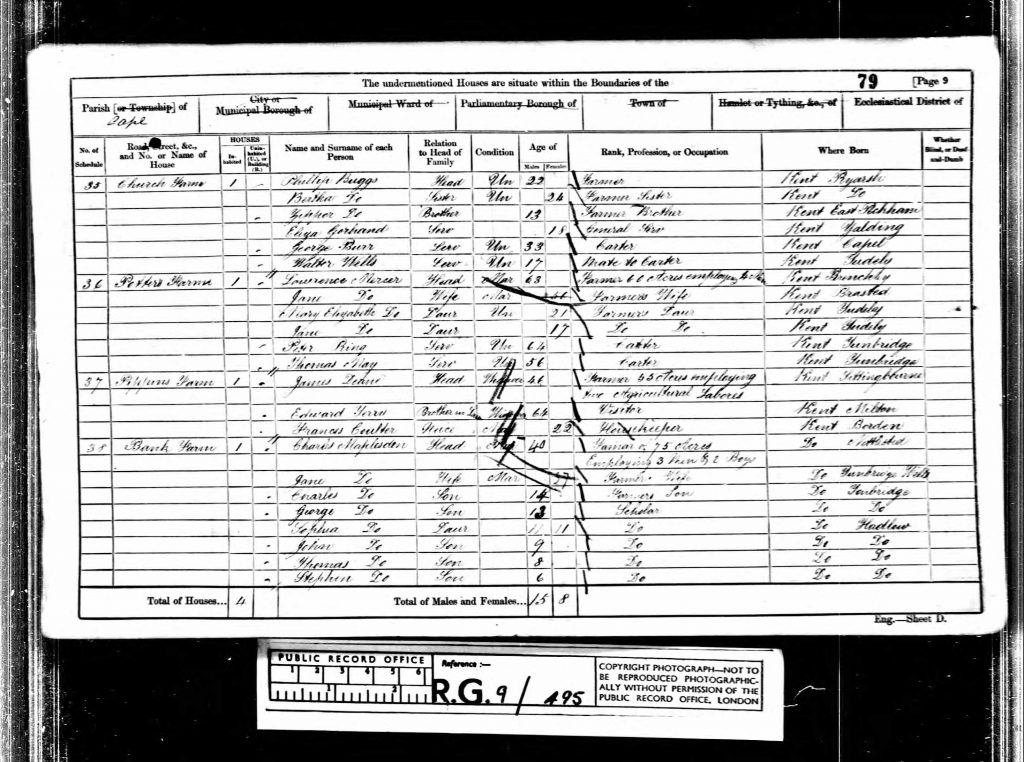
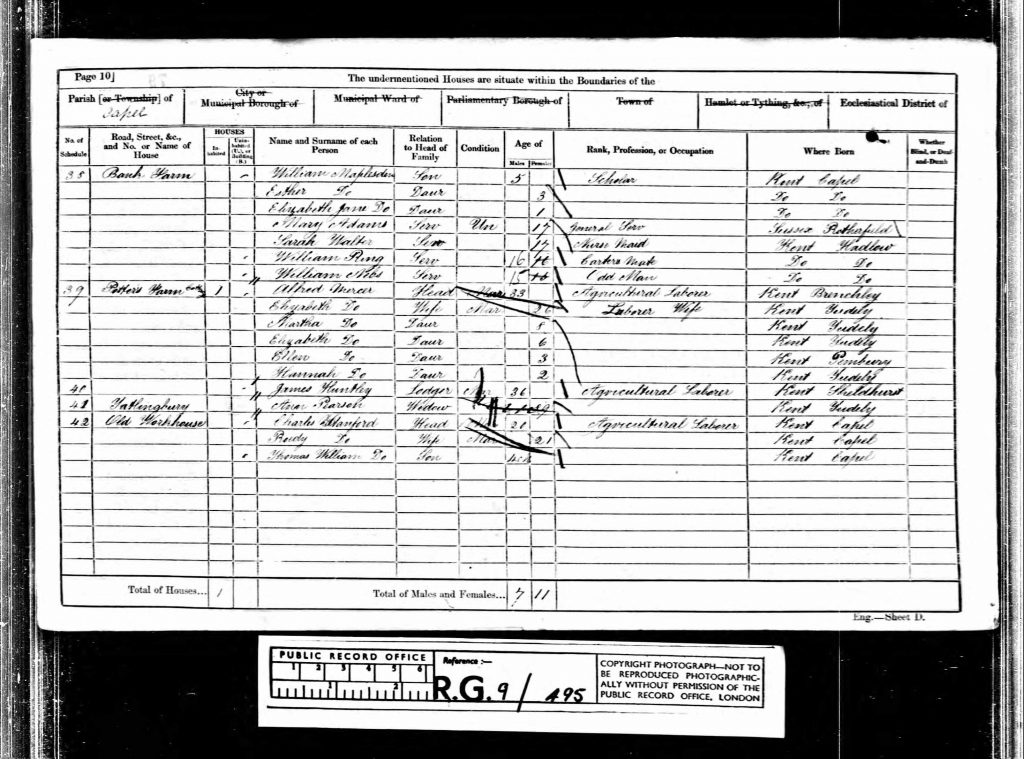
On 20th July 1861, now aged 37, Jane gave birth for a tenth time, to another son who they named Henry Marshall MAPLESDEN. Jane then became pregnant for an eleventh time in or around September 1862 but it is clear that Charles and Jane’s marriage was by now, already failing.
Scandal at Bank Farm
While Jane was pregnant with the couple’s eleventh child together, in or around November or December 1872, Jane’s husband Charles must have began a relationship with the family’s young servant girl, Mary ADAMS, because shortly afterwards, she became pregnant by him. It seems that Mary was then given a cottage on the farm at Hadlow to live in.
On 18th May 1863, Jane Maplesden gave birth to the couple’s eleventh child, a daughter, who they named Alice Clara MAPLESDEN. Just two months later and perhaps unbeknown to Jane at the time, on 12th July 1863, Mary Adams also gave birth to a daughter in Hadlow. This baby was Charles’ daughter, but as Mary was an unmarried young woman, and Charles was already married to Jane, Mary gave her illegitimate daughter her own surname and called her Emily ADAMS.
Scandalously, Charles continued his relationship with the young Mary, and began to frequently visit the cottage where she was living. Meanwhile, he treated Jane terribly and beat her frequently. However, he must have continued to have intimate relations her, because in or around May 1864, Jane became pregnant for the twelfth time.
Charles continued his relationship with Mary Adams however, and in or around November 1864, Mary also became pregnant by him. So both women were then pregnant with his children at the same time.
A Tragic Death in the Family
Tragically, on 11th January 1865, while Jane was heavily pregnant for the twelfth time, her young son, William MAPLESDEN, who was aged just 8 years old, died.
Jane must have been utterly bereft, being pregnant, in an unhappy marriage, and now losing one of her children. However, she had little time to grieve because the very next month, on 11th February 1865, she went into labour again and gave birth for what would be her twelfth and final time. She had another son, who was named James Sawyer MAPLESDEN.
Meanwhile, Mary Adams was still pregnant and expecting her second child imminently to arrive. Mary had been living, and raising her young illegitimate daughter, there at the cottage on the farm in Hadlow.
On 7th July 1865, just a few months after Jane had lost one of her sons and then given birth shortly afterwards, her husband’s mistress Mary Adams gave birth for a second time. She had another daughter, who was named Margaret ADAMS.
Despite these events and the humiliation Jane must have felt, Jane remained living with her children at Bank Farm in Capel while Charles then seems to have moved in full-time with Mary Adams into a cottage on the farm at Capel, close to Jane and the children living in the farm house.
Charles and Mary then had two further children together over the next couple of years.
This must have been very hard for Jane to cope with, and it seems that, just as her father had done during her childhood, she began to turn to drink for solace. She may also have looked to others nearby to get some much-needed attention and affection.
The Maplesden Family in Court
In 1868, Charles and Jane had a terrible fight and Charles struck Jane particularly hard. In her own words which were recorded some time later, “He struck me several violent blows in the face and also, at the same time and place, kicked me on the lower part of my body”
Things only got worse however, and the following year Charles and Jane got into another almighty fight that would bring about the end of the current living arrangements and land the family in court.
On the evening of Monday 28th June 1869 between the hours of 9pm and 10pm at night, Charles struck Jane several times and then threatened to murder her. She said he “struck me three violent blows to the head and face and threatened to murder me”. The very next day he “ordered me to leave his house and threatened to murder me unless I did so, whereupon being apprehensive that he would carry his menace into execution I left his house and have ever since lived separate and apart from him.”
It seems that after he had forced Jane to leave the farm, he had his mistress Mary take her place, because on 1st July 1869, when Jane and Charles’ eldest son, also named Charles Maplesden, returned home to the farm to find that his mother had been kicked out and Mary was in the house, a serious altercation took place and he ended up assaulting Mary.
This event resulted in the whole family making an appearance in court in front of a large assembly of people. It was reported in the Maidstone Telegraph and West Kent Messenger Newspaper on 10th July 1869. The article included the sub-heading “Gross Immorality at Capel” and went on to report that:
“George Maplesden, a young man of the parish of Capel, carpenter, was summoned, charged with assaulting Mary Adams, on the 1st July. Mr Palmer, solicitor, appeared for the defendant. Complainant [Mary Adams] deposed –
“I am a single woman, living in a cottage on defendant’s father’s farm, at Capel. On the 1st July, I was sent up to the farm house to put away the clothes and take care of the children. Defendant slept in his father’s house, and he ordered me to leave the place. I told him he was not my master, and unless my master gave me orders, I should not leave. He beat me with his fist on the face, neck, and breast, and made a mark on my eye, which now remains. He drove me down to the cottage, and swore he would swing for me, and would murder me in the wood. Since that time he has threatened to take my life. he tried to get into my cottage, but the neighbours advised him not to do so, and I locked the doors to keep him out.”
Under cross-examination, Mary went on to report “I was sent for to the farm house by Mr Maplesden, and did not find Mrs Maplesden at home. I have known her for nine years, and I am aware she is the mother of thirteen children, eleven of whom are living. I occupy Mr Maplesden’s cottage, and he lives with me, and I have had four children by him.”
The Chairman of the court then asks “Does she refer to the father of the defendant?” and Mr Palmer, the solicitor appearing for the defendant says “Yes Sir”.
Mary continued “When defendant [George Maplesden junior] came home he found his mother away and I in her place. I had been washing and starching shirts. I was ordered there by his father, and defendant knew I carried on intercourse with Mr Maplesden. There were little children in the house, the youngest being about four years of age. My four children and Mr Maplesden live with me in the cottage, and he slept with me last night. I have a witness who saw defendant knock me down.”
The Chairman of the court asked “Is it your child?” and Mary said “No, a sister of defendant, twelve years of age”. The Chairman then asked Charles’ solicitor, Mr Palmer “Do you deny the assault?” and Mr Palmer replied “No, I pleaded not guilty in order to be able to cross-examine complainant.”
The report goes on to explain that Mr Palmer did not wish to claim his client was not guilty.
“He said there was no need of addressing any remarks to the bench. His client, with a proper love for his mother, came home, found this wretched, shame-less woman in the house, his mother turned out, and this woman occupying her place. he felt sure the bench would see there was a very great amount of provocation, and he hoped as light a fine as possible would be inflicted and that complainant would be ordered to pay her own costs.”
The Chairman then made his judgement in the case and the report explains
“The Chairman said there was no doubt defendant had great provocation, but that did not give him the privilege of taking the law into his own hands, therefore the Bench were obliged to inflict a fine of 5s and 9s costs. The money was paid.”

The same article then goes on to explain that Jane Maplesden had her own request of the court. It states
“Mr Palmer stated that Jane, wife of Charles Maplesden (father of defendant) asked the Bench to order her husband to be bound over to keep the peace. On the evening of 29th June, between the hours of nine and ten o’clock, Mr Maplesden struck his wife three times with great violence, and the next morning turned her out of doors. He wished the man to find substantial sureties to keep the peace. The Chairman inquired if Mr Palmer did not charge the man with an assault, and the solicitor said he only desired the man to be bound over to keep the peace. Mrs Maplesden was called and said ‘I remember Monday the 28th June.‘
But then it seems that Charles Maplesden the senior must have interrupted, because the newspaper article explains that the ‘defendant’ said to Jane “No, you don’t, you were so drunk”.
Jane then said “My husband came in, abused me, swore at me, and said he would kill me before morning. The next morning he swore he would murder me if I did not go out of the house. I am in danger of my life, and ask him to find sureties to keep the peace.”
Seemingly not denying these events, Charles then accuses Jane of being a drunkard and acting inappropriately with local men. The article reports that the defendant said “She has been drunk for the past fortnight, and out in company of the young men of the place. I’ll never keep her or live with her again. Now it has come to this I’ll have a separation if it costs me £1000. I have two sureties here.”
The court then seems to have made a decision as the article reports “The Bench required defendant to be bound himself in £40 and two sureties in £20 each to keep the peace. When Mr Maplesden left the court, in company of the woman Adams, he was greeted with the hootings of a large assemblage”.
Jane Files for Divorce
A few days later, and less than a month after she had been forced to leave Bank Farm, on 10th July 1869, Jane wrote a petition for a divorce which she then filed on 15th July 1869. The petition ‘Maplesden V Maplesden’ provides an account of all that she experienced from Charles during the marriage. She formally names Mary Adams as the woman he committed adultery with and with whom he sired two children outside of the marriage.
All Jane asks for, in her divorce petition, is that the court will award her the custody of her own children. In the late 19th century, a man legally owned everything and a wife had few rights, not even over her children if they separated.
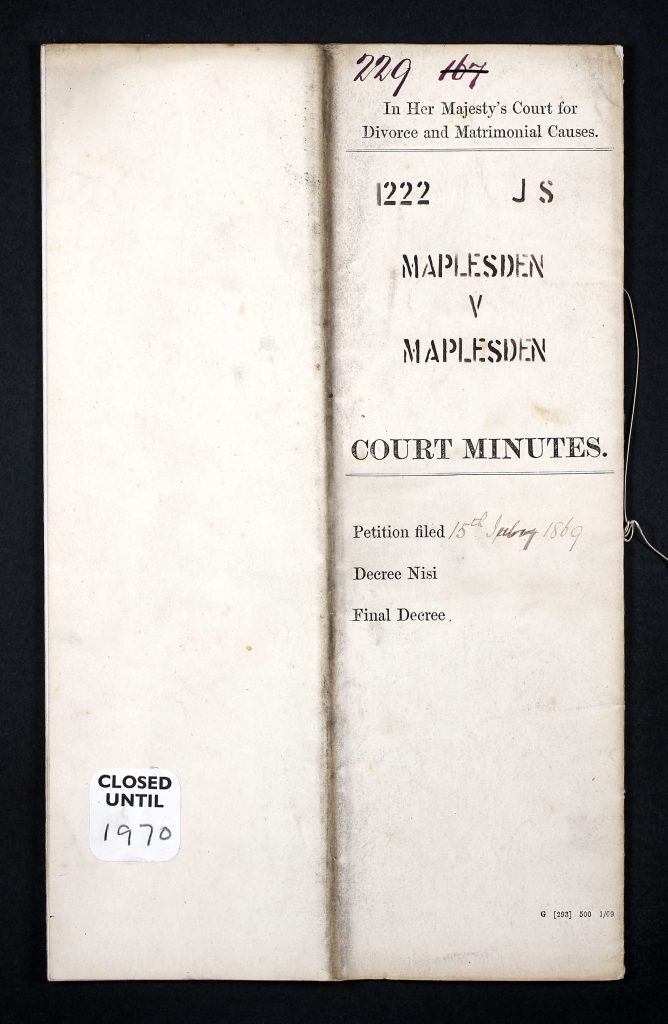
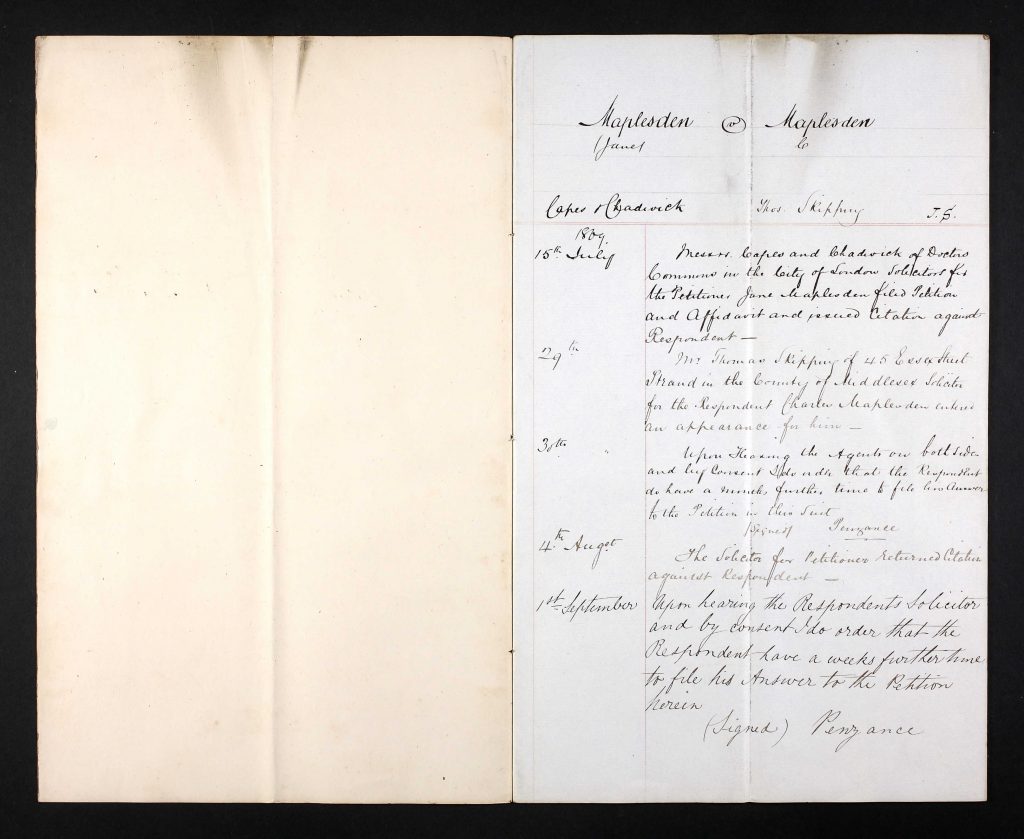
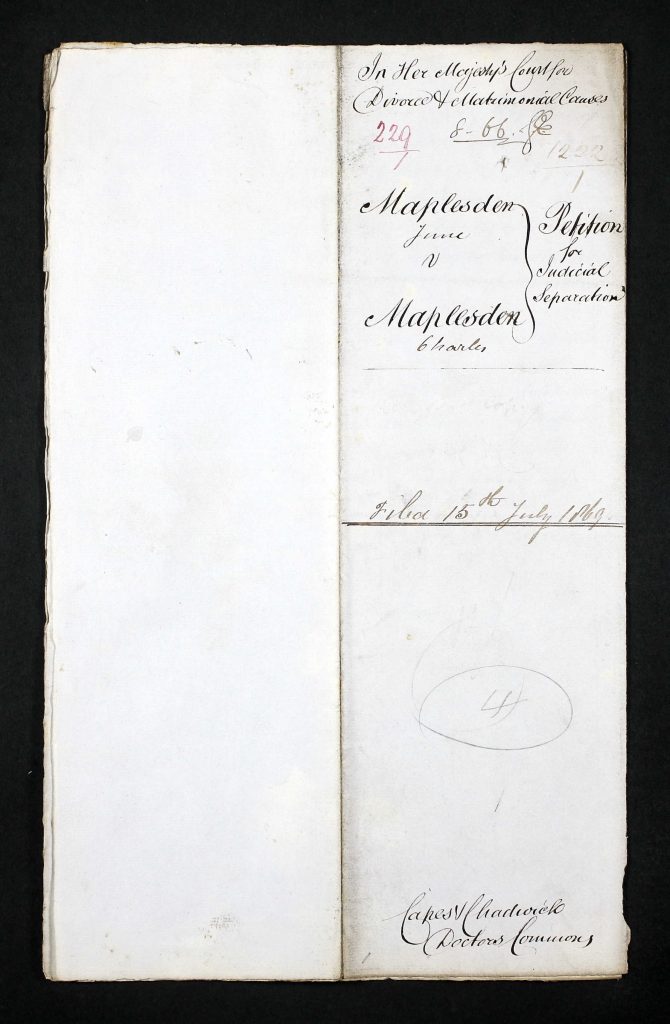
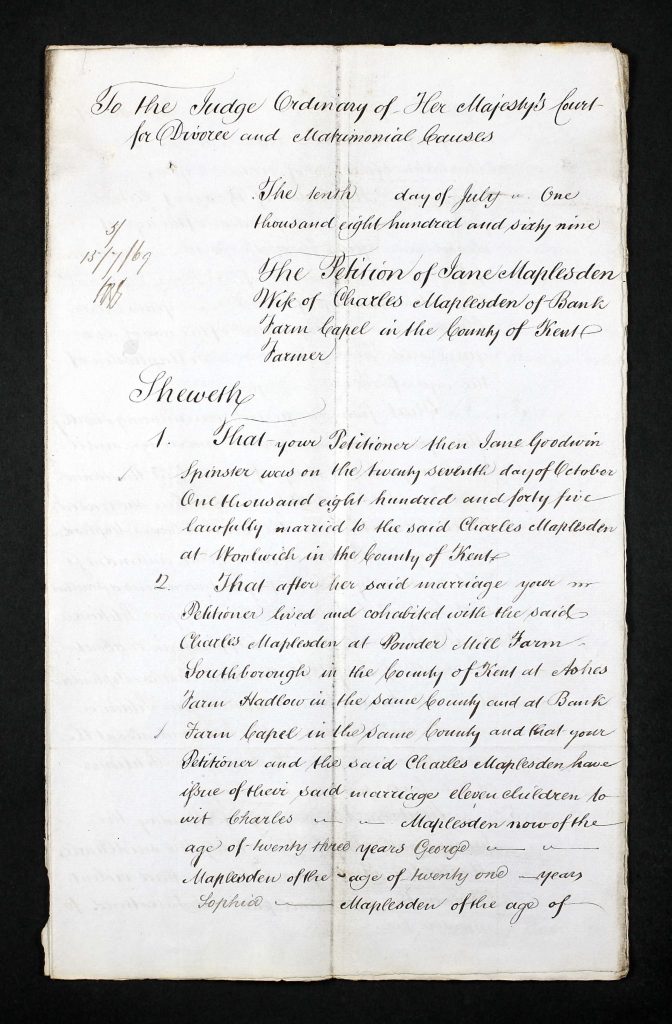
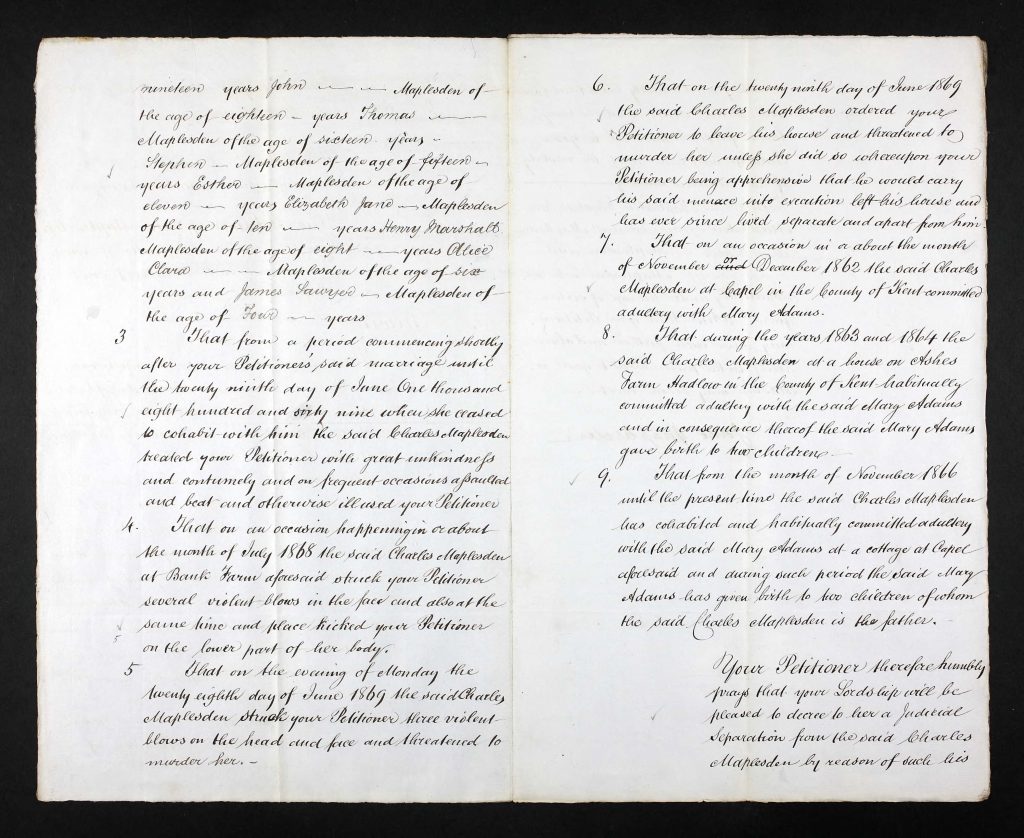
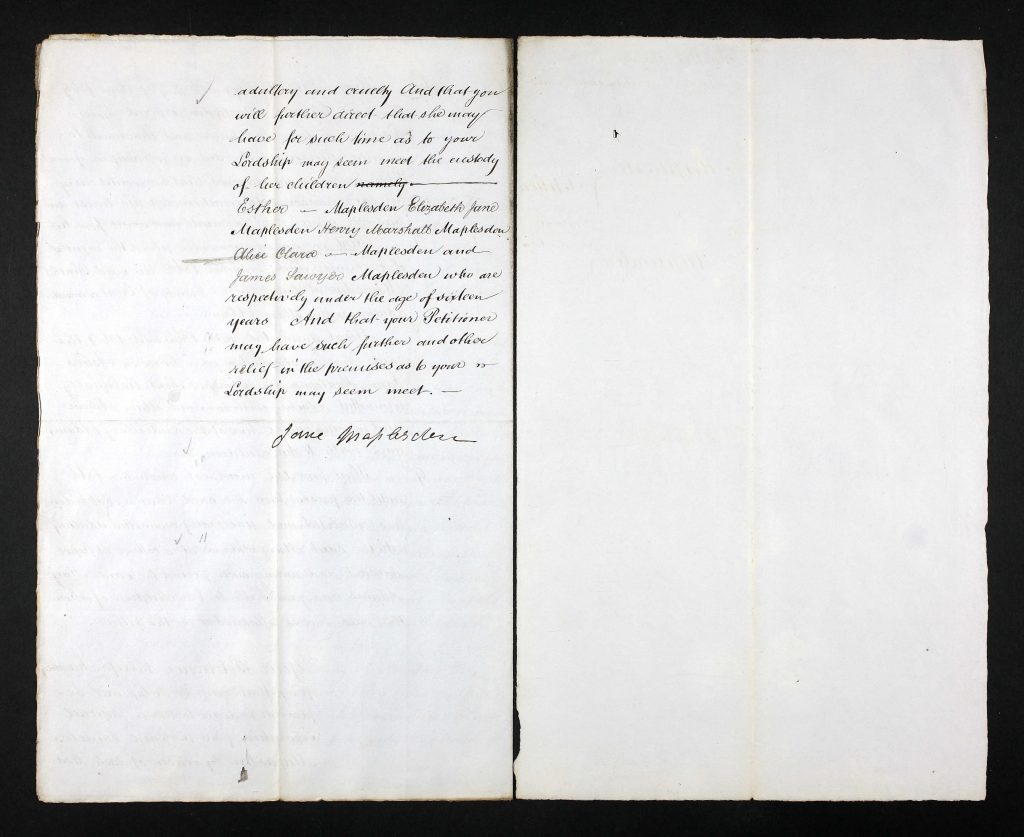
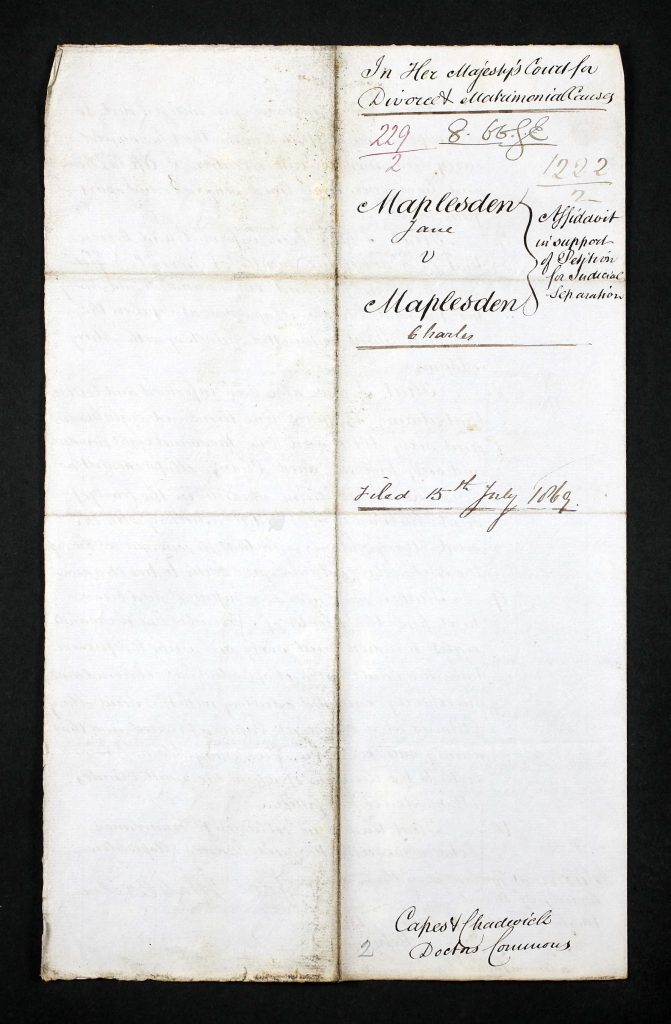
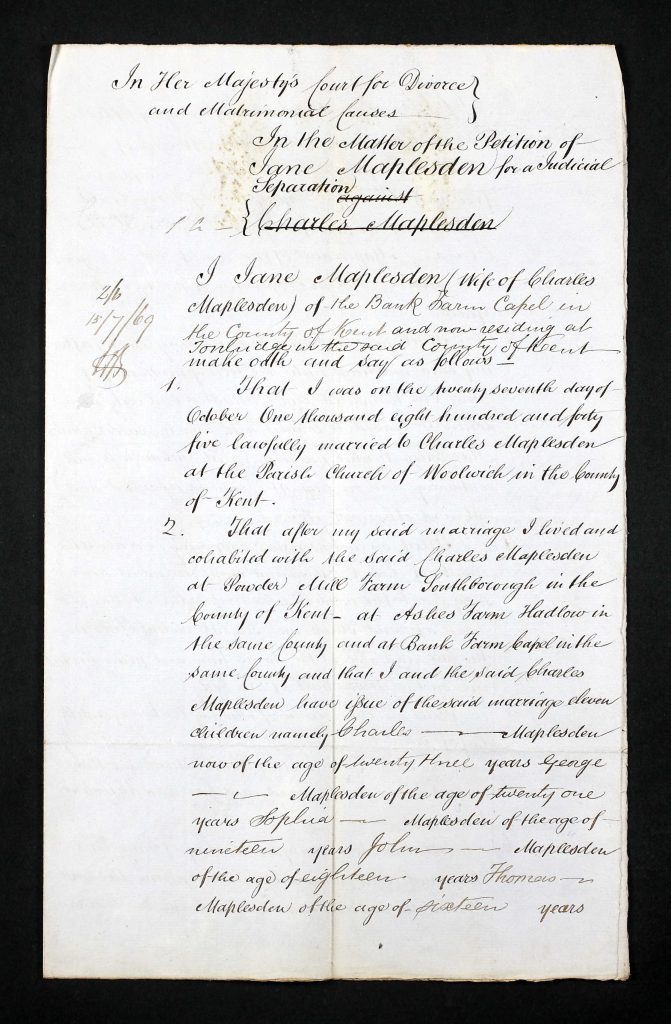
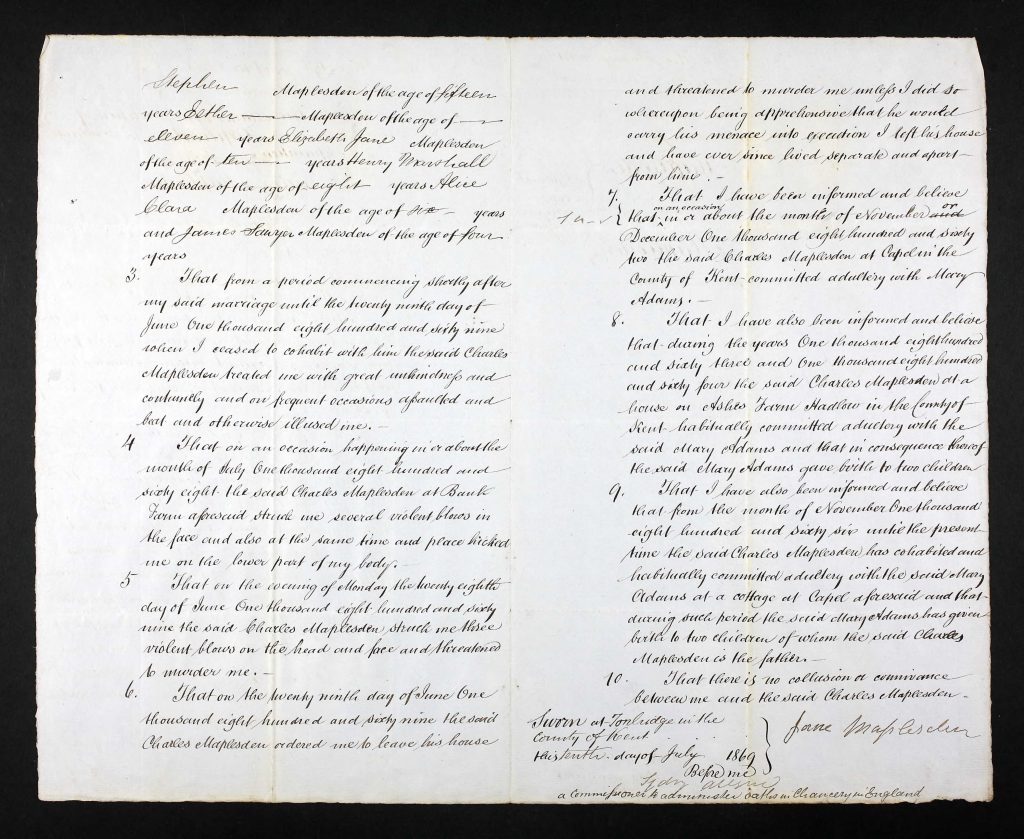
What Jane Did Next
Unfortunately, although it’s not clear what the exact outcome of the divorce petition was, some clues can be found to suggest that it did not work out at all happily for Jane. There is reason to suspect that for some reason, the divorce was not in fact, granted. Moreover, she does not seem to have been awarded custody of her children.
Despite her desperate plight, and the ill treatment she claimed to have been subjected to by the hands of her husband, it seems that Mary Adams would get Jane’s husband, her home, AND would take custody of all of her children too. Even worse for Jane, Jane’s youngest son James, who was the child mentioned in the court proceedings as being only four years old when Jane was forced to leave him, very sadly passed away at the age of only five years old, in 1870.
What Next for the Maplesdens
By the time of the 1871 Census, Charles Maplesden is listed as still living at Bank Farm, now aged 51. Although he’s entered on the census as ‘Married’ his wife Jane is no longer listed as living there with him. Professionally, Charles seems to be doing well. He is detailed as still running the farm of 75 acres, and now he is listed as employer of 5 people. However, domestically, things seem complicated. He appears to have kept all the children he had with Jane, except those who are by now adults and who seem to have left home to go to work or marry. He is living at Bank Farm along with his son Stephen (aged 16), daughter Esther (13), Elizabeth (11), Henry (9) and Alice (7). His youngest son with Jane is not listed because he had died the year before when he was only 5.
Also living there at the farm with Charles is Mary Adams. Although Jane has gone, and Mary is now aged 29 and has a number of children by Charles, the family list her as still being unmarried. They state that she is there at Bank Farm working as a ‘servant’ in the role of “House Keeper”. A number of other children are listed as being sons and daughters of the Head of the house, namely Emily Adams (aged 7), Margaret Adams (5), James Adams (4) and a new baby, Charles Adams, aged just three months old. Interestingly, the first two Adams children, Emily and Margaret Adams, are listed as having been born at Hadlow, whereas the second two are listed as being born at Capel. Given that Mary Adams had previously claimed that she had had four children by Charles while living in the cottage, it seems as though two of those children may have passed away.
Additionally, living at the farm is Charles’ unmarried elderly sister, Mary Maplesden (aged 69). She is described as a ‘Lunatic’.
Jane’s Life After Charles
It’s not clear what happened to Jane after she left Bank Farm, and there are very few records that I could access. However, it seems that she went to live with a man named David BRIDGES who had previously also been living in Capel. He had lived there with his family in Capel before being widowed.
The 1861 Census shows her (now aged 47) living with David BRIDGES and states that he is a Widower and a Labourer (aged 49) in New Bromptom St Mark. Also, her son, Thomas MAPLESDEN (My GG Grandfather), was living there with them both too. He was now aged 18 years old and was listed as also working as a Labourer. Jane was listed as a ‘Housekeeper’, however it seems likely that she was actually in a relationship of some kind with David because he would still be present right at the end of her life some years later. Perhaps he had been involved with Jane at the time when things went so dramatically wrong with her husband and when she was made to leave Bank Farm.
By the time of the 1871 Census, Jane is still living with David BRIDGES, but now they are living together in Dover. She is listed as a ‘Housekeeper’ again, although it does seem more likely that they were in a relationship. He was 58 and she 57 by this point. She also appears to be living next door to her brother at this time, Henry GOODWIN, his wife Elizabeth and their children Henry, Edward, George and Marian, so I would like to think that she found a little domestic happiness for a time at least.
Unfortunately, records show that she must have contracted Consumption and that she also had a quite a significant drinking problem, as her father had before her, but which does not seem to be enitrely unexpected given the very difficult circumstances she had endured for many years in a time when there was no mental health support or rights for women. She had grown increasingly physically frail, and she also became seriously mentally unwell.
In or around November 1885, it seems that Jane became became very unwell indeed, and by May of the following year she needed to be admitted to an Asylum for treatment.
Jane is Admitted to St Augustine’s Asylum
At the age of 62, Jane received medical attention and was provided with a medical certificate by Dr Arthur Long MRES of Dover. She was then admitted on 31st May 1886, by order of Dr Thomas V Brown of Dover, to St Augustine’s Lunatic Asylum in Chartham, Kent. Her admission notes for the asylum provide the only known surviving picture of Jane, and she certainly does not look at all well.
According to her admission notes, she had been unwell for around 7 months, and was now very weak, thin (weighing just 6 and a half stones), had varicose veins in both legs, and she was suffering from Melancholia. The notes say that she was Suicidal.
The causes of all this were identified as (1) Drink (2) Heredity and (3) “Domestic Trouble”. Interestingly, she is described as Married, and Charles Maplesden (her husband), of Bank Farm, Capel, is named as her “Friend”. This suggests that her petition for divorce had not been granted and she was still married.
The notes also provide a small addition, written in red in the margin, to say that her Mother had died a Lunatic, and that her father had been a “Drunkard”.
Comments are noted from the attending physician that “In her communication she only ever speaks of what passed in her childhood, as if now happening, as thinking I am the medical man who attended her father who died 52 years ago and telling me she is now living where she used to live years ago”
“Other facts” are provided by a woman named Alice Philipps, she is documented as having said “The other day she took a can of paraffin and poured on the fire, and when I tried to prevent her she tried to strike me with the tongs”.
There is also a short, very sad line of text revealing that she had been very distressed. It does suggest that David Bridges, who she was living with, was involved in trying to help her. He is quoted as saying “She frequently threatens to cut her throat”.
It also seemed that she had been suffering from Consumption, also known as Tuberculosis, as sadly, the final notes in her log book at the asylum revealed that she died due to Consumption in November 1886.
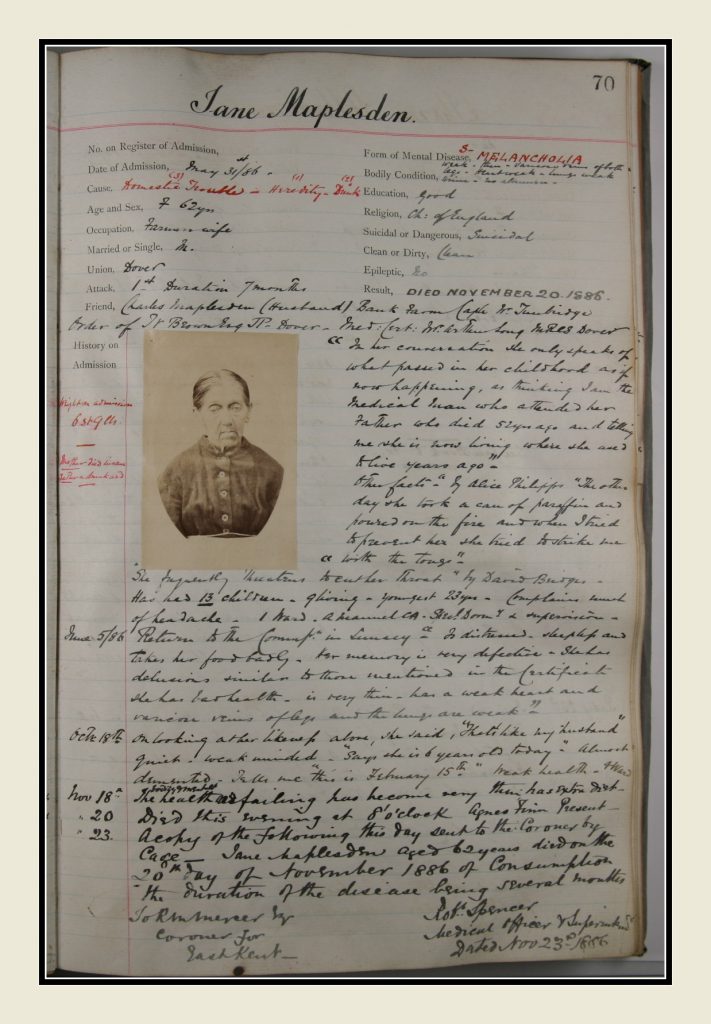
Jane Maplesden’s Death
After spending much of her final months in St Augustine’s Asylum, Jane passed away on 20th November 1886 – Cause of death ‘Consumption’.
After Jane’s death, Charles does not seem to have ever married Mary Adams though he does seem to have stayed with her to the end of their days. On the 1891 Census, Charles is still living at Bank Farm, but now he is described as a Widower and is a ‘Retired Farmer’ at the age of 71, no longer employing anyone. Mary Adams is 48 and is still living with him, described as a ‘Spinster’ and still listed as a “House Keeper” even though it must have been well-known that she was living there as his common-law wife. They have three more young children now living with them, the older ones having by now left home. On the census are Frederick Adams (aged 16), George Adams (13) and Mary Ann Adams, most likely named after her mother (9). This must have been a challenging time for the Adams children to have grown up illegitimate, with the gossip surrounding the family.
A descendant of George Adams contacted me in 2020, and told me that George had gone on to marry and have a baby and then he moved his young family to the United States, leaving his family and siblings behind him. There they established a new branch of the family tree based in America.
As for Jane, one of her sons, Thomas Maplesden (my own Great Great Grandfather), would go on to marry a young woman named Mary Emma Barnes, who I have also written about, but unfortunately, he would also end up being a poor husband and he abandoned his family and was accused of neglect too. You can read about the next generation of Maplesdens Here.

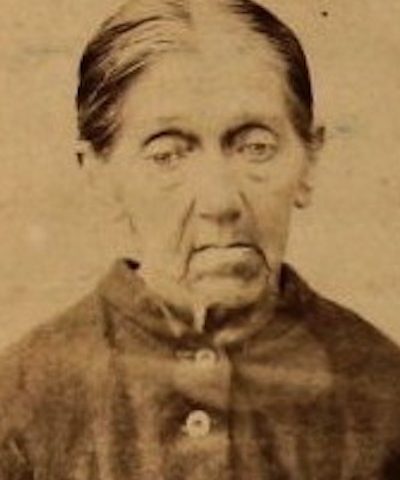
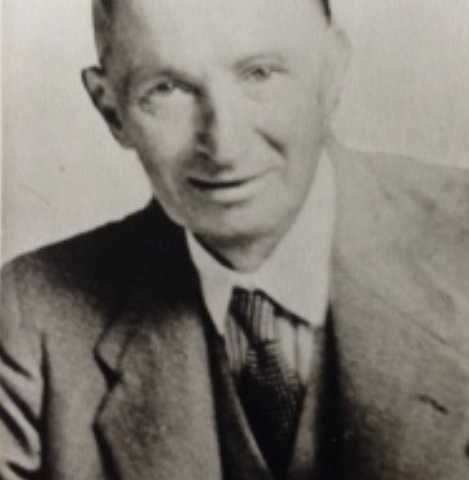
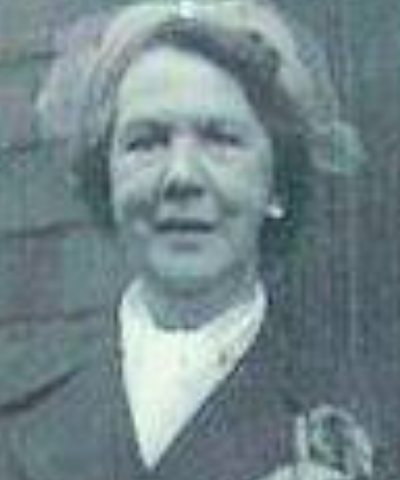

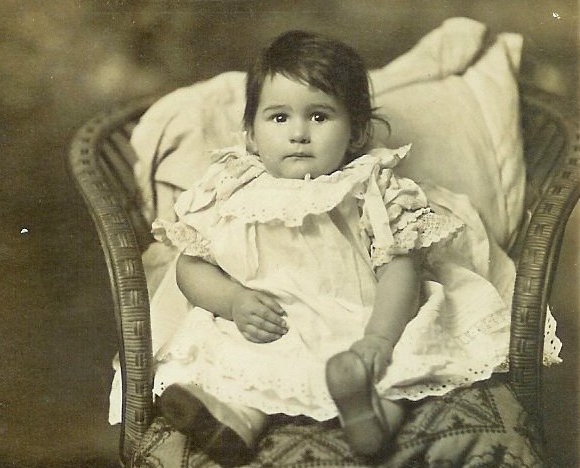
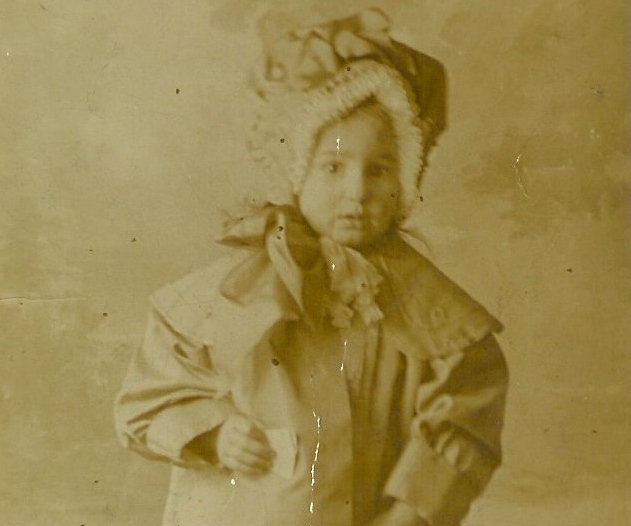
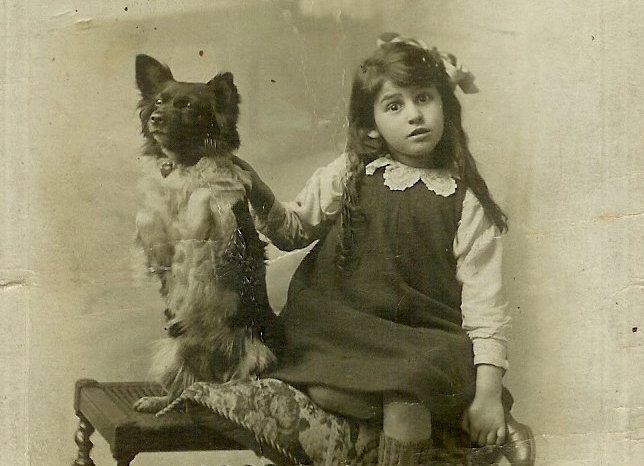
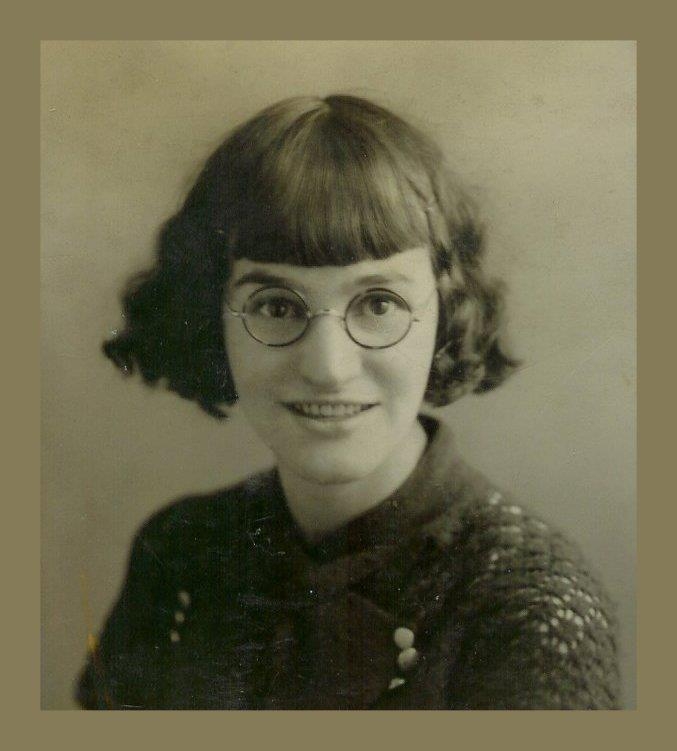
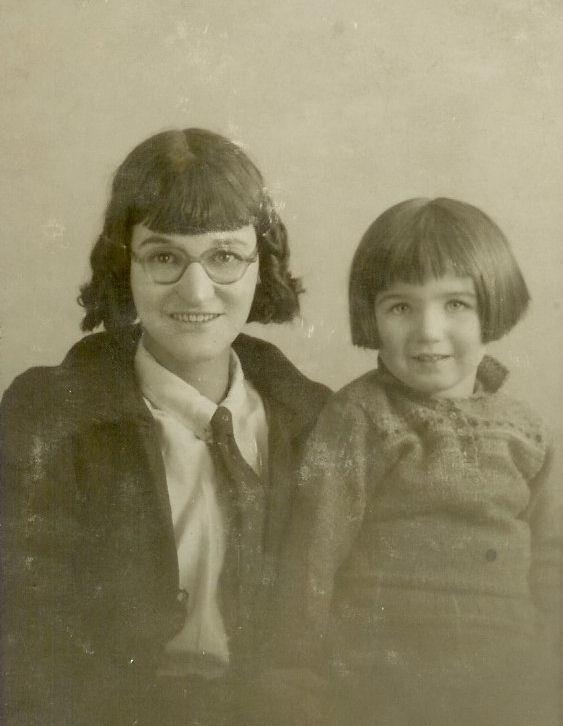
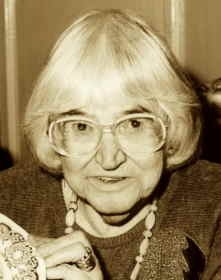
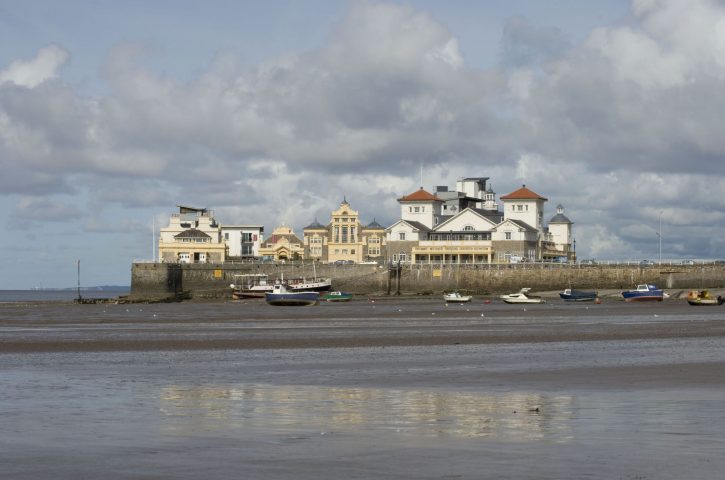
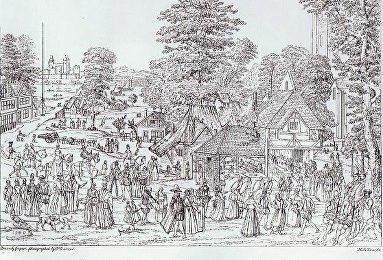
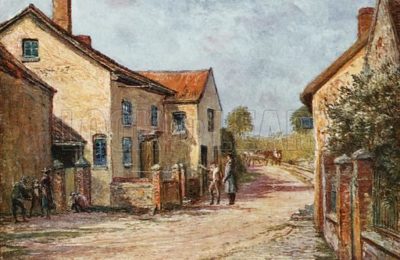
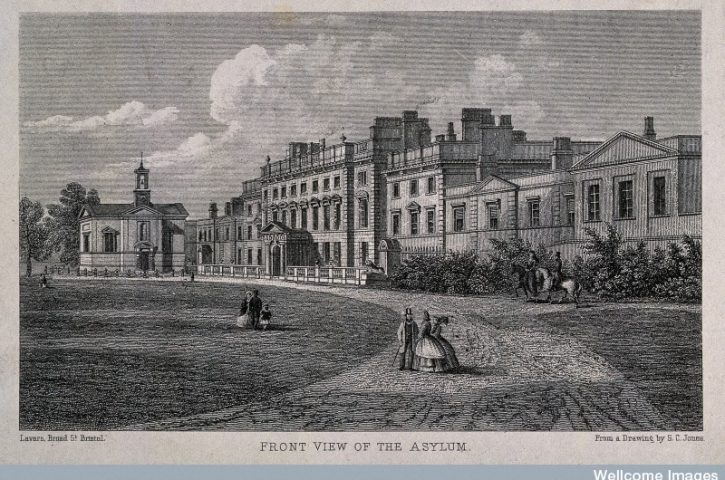
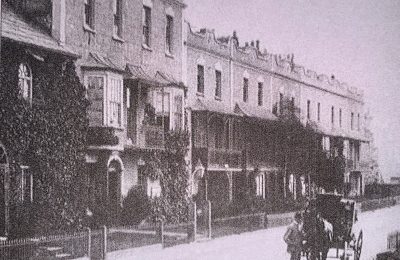
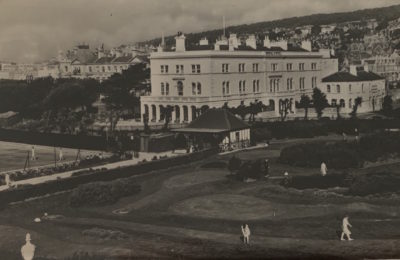
Thank you for putting this all together. It is a fascinating read, and so sad. I am descended from one of Charles and Mary Ann’s sons, George.
I’m so glad you found it interesting, though, yes it does seem to have been quite a sad story for Jane at least. Interestingly and also rather tragically, the son of Charles and Jane that I am descended from, Thomas, went on to marry Mary Emma BARNES (you can read about her on my blog) and he was not a good husband to his own wife either by all accounts. According to some newspaper clippings he was accused of abandonment and neglect. Ultimately, he abandoned his wife and his children too, and just disappeared one day. One of their daughters (my own Great Grandmother Rosa Maplesden) was only 10 years old at the time that he vanished from the family. She grew up to have several illegitimate children herself and by all accounts, made for a terrible mother! My own Grandmother Mary Brine, her first daughter, wrote an autobiography about her childhood which told of beatings, neglect and abandonment. As a Psychologist it all fascinates me greatly, though it’s of course a tragic family tale, because of the often inter-generational patterns you can pick up in families and how trauma many years ago often seems to leave an impact that can be seen later on in the family line. It would seem that you are my 4th cousin, I hope our generation can right some of the wrongs of the family’s past and lay some old ghosts to rest 🙂
A sad sad sad story indeed.
My grt grandmother was Emily Adams.Who later came to London and worked in service to a politician,and later worked at At James’s Palace,wher she met my grt grandfather who was what was called “A gentleman’s gentleman”,to Queen Victoria’s uncle The Duke of Cambridge,George.
A happy marriage it seems.
So she put all the unhappiness behind her.
Hello! I think we must be 4th cousins then? That’s really interesting that she ended up in service at St James’ Palace! What was her married name? Do you have any photos or anything? I would love to one day find a photo or portrait of Charles Maplesden, Mary Adams etc though I do wonder whether this photo of Jane Maplesden only exists because she ended up in the asylum. Do let me know if you have any further information about the family or what happened to any of them!
Keeping my fingers crossed that someday a photo of one of them will appear. I am afraid you may be correct in that we only see Jane’s picture due to the circumstances. I am trying to obtain photos of Charles and Jane and/or Charles and Mary Ann’s children.
Hi Brian, yes pictures would be amazing! Hope something turns up one day!
It must have been a very interesting family dynamic, especially since the farmhouse was not that large. Following the Census, in 1881, neither Charles nor Jane were living at Bank Farm. On the Census, Charles and Jane’s son, Henry Marshall Maplesden, aged 20, was listed as the head of household. He seemed to be raising the younger 6 of Mary Ann Adams children, aged 15 to 3 years. Funny enough, Henry went on to marry Kate Hannah Adams, younger sister of Mary Ann Adams.
I have tried to follow Charles in the newspaper archives, to get a better picture of him and his life. Through the whole thing, I have mixed feelings on him. He is my 2x great grandfather, even if not by name. I read about the cruelty first and didn’t have kind thoughts about him. Some of the other articles find him being taken advantage of, robbed, etc. Then I felt sorry for him. Through it all, I did feel bad for Jane. But it did seem that Charles may have had love for Mary Ann, even if she started as his young servant. They were together until the end. It seems that she got part of his money after his death, that his own Maplesden children didn’t get. My great grandfather, George, headed to the US with is wife and baby not long after his mother’s death. He never went back.
Hi Brian, Wow that’s really interesting about Henry and Mary Adams younger sister! What complex dynamics!! And I wonder why he ended up raising those children, where was Mary Ann at that time? And yes I agree it does seem that Charles fell for the young Mary Ann and they clearly had a long lasting relationship after that. I would like to think that Jane found some happiness with the gentleman she lived with for a while, even though she obviously ended up quite unwell at the end of her life. I found it most surprising that Charles fathered children with both Jane and Mary Ann at the same time!? I wonder why. If the marriage had broken down with Jane, then why still have more children with her, and I also wonder what Mary Ann thought about that too? A very intriguing tale all round!
Yes, very interesting dynamic indeed. Charles and Jane’s daughter Alice Clara was born in 1863, the same year that Charles and Mary Ann’s first daughter Emily was born. I am guessing things got stressful from there. Jane went on to have her last two children (sons) in 1865 and 1866 that only lived for a few years each. In 1865 and 1867, Charles and Mary Ann had two more children together.
I found a newspaper article from 1867 where Charles and Jane’s second eldest son, George, was charged with assaulting Mary Ann Adams.
In it, she states, she was following her master’s orders. I wondered what kind of life she had. She stayed with Charles for him to father the rest of her children. She was with him when he died. I guess I sense that he was more than just her master and that there was some love there.
I’m sure that there was love there. It must have been a challenging situation for them all, but I can’t imagine that Mar Ann would have had so many children with him and been by his side at the end if there was not a loving relationship there. I hope that Jane also found some happiness in her later life before her illness.
Hello Honey Langcaster-James, my husband is Michael Gibb and Charles and Janes’ son Henry Marshall Maplesden was his Great Grandfather who we know was living with his son Charles and his wife Emma Sarah Maplesden Nee Poet in Court Lane Hadlow in 1939. Charles Senior is buried in Hadlow Cemetery and Jane is remembered on the gravestone although we believe she was buried at Chartham Asylum and her remains have since been dug up to clear the area for a housing estate although no official can tell us what happened to these remains, which we find very sad. We have also researched and found all the relevant information you have listed above – such a sad story. When researching in Maidstone Archives we came across the above page where it shows Janes’ entry into Chartham – my husband burst into tears as she looked such a poor little thing and as if she had completely given up all hope. Kind Regards Diana Gibb
Hi Diana, Thank you SO much for getting in touch and for sharing all this information. I too was very sad when I first read her admission record and for a while I did think her life had been an entirely tragic one. I take some comfort in the clue that she might possibly have found some love and affection in the gentleman she went on to live with. She certainly seemed to have a really tough time though. During the recent break in ordinary life, I actually managed to go and visit the grave in Hadlow and I did see the gravestone of Charles and Jane. I assumed she was buried in there and at first I was ambivalent about the idea of the fact that she might have been buried with Charles, given there didn’t seem to be any kindness towards her from him. Though, as with many things in life, I guess there are often more than one side to a story. So I’m not sure whether it was better that she wasn’t buried there with him, or not, given that you have reason to believe her remains were removed. That is really sad. Life can be so unfair sometimes. Still, we are remembering her now, and with fondness and compassion 🙂 It’s lovely to hear from you. It seems that one of the other sons of Charles and Jane, Thomas, who was my own direct ancestor, went to live with Jane and the gentleman who she was later living with. He later married my Great Great Grandmother Mary Emma Barnes (who you can read about on my blog), but he went on to abandon his own family in Yorkshire and I believe he moved back to Kent but his children never knew what happened to him! This seems to have left it’s mark I think on my Great Grandmother Rosa Maplesden (who you can also read about) and she went on to make a terrible mother by all accounts to my Grandmother (Mary Brine nee Mary Maplesden, again who you can read about). She ended up writing her autobiography about her childhood and family’s past, you might find it interesting! As a Psychologist myself, it fascinates me, but also saddens me, how trauma in a family can often set a family down a long pathway of tragedy and patterns of relating. I hope that by uncovering all of this and reflecting upon it, we can turn the family tide 🙂
I’ve just noticed your post which came up while I was looking for the Templecombe census entries to see if that would add anything to what I know about my great-great grandparents, William and Jemima. Hannah was my great grandmother which make us, by my calculation, second cousins twice removed. My grandfather was Polly’s younger brother, William Henry, who married Clara Drake, originally from Suffolk but living in London when he met her.
My father, Frank, never mentioned his uncles and aunts of whom Polly would have been one, and until it was too late to ask I never felt any curiosity about my ancestors. Do you have any further information about the Barnes’s past history? I have one or two stories about the family past which I could let you have if you are interested.
With best wishes
Lionel Barnes
Hi Lionel, I’m so sorry I’ve only just seen your comment. It does sound like we’re distantly related!! I don’t have any other information other than what I’ve shared on the blog, although you might be interested to read my Grandmother’s book “Hopwood Street to Wellington Lane” if you’re interested in Polly and that side of the family as she talks about them in there a bit. I would LOVE you to share any family stories you have?? Please do feel free to share them here in case anyone else stumbles across the blog and is researching the family? Best wishes, Honey